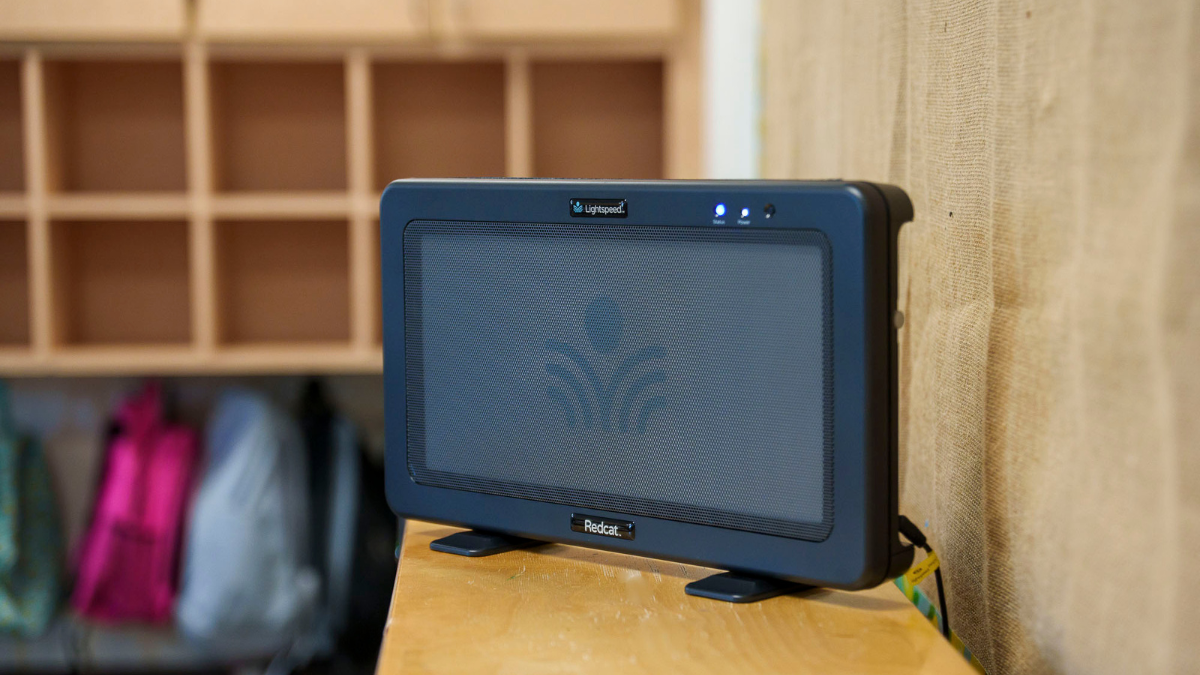by Michael Aushenker
Call it state-of-the-art and a sign of the times.
Mountain View Elementary School has adopted a Classroom Audio Technology, or CAT, the system where the teacher wears a microphone that projects his or her voice for all students to hear, even in a noisy classroom.
“You put a microphone on a classroom teacher, and something very positive happens,” said Ron Sams, a consultant for Lightspeed Technologies, maker of the CAT devices. “Kids can hear instruction no matter where they are in the classroom.”
In January, Mountain View piloted Lightspeed’s Topcat and Flexcat devices. By August, the Fletcher Avenue school had fully installed the system.
“What the Topcat provides is a wireless media connector,” Sams said of the system, in which a speaker is installed in the ceiling.
“It’s an all-in-one amplifier speaker; the audio hub for the classroom.”
Some rooms also received Flexcat pod systems, which allow for bi-directional communication between small student groups and the teacher. With the Flexcat, the teacher wears an earpiece while the speaker pod can be placed anywhere. Students can even plug headphones into the pod.
“If they want to get a hold of me, there’s one button,” Mountain View teacher Jamie Reese said.
Principal Jennifer Goldman said 18 Mountain View classrooms have Topcats, while five also employ Flexcats.
The principal said she originally pursued the system to address the needs of deaf/hard-of-hearing students.”
“We have a class for (deaf and hard-of-hearing) students who are developmentally delayed but we also have students with typical cognition.”
Once Goldman’s research into the systems deepened, she learned of the technology’s benefits for all kids.
“Many teachers have expressed that they love the systems,” she said. “They are less fatigued (by day’s end) and the students hear them better. (Conversely), students say they can hear better and they love using the student microphone.”
Reese said the “teacher voice” she used to use took a lot out of her.
“(Now) I don’t have to redirect kids as frequently,” she said. “They can hear me no matter where they are in the room. They don’t have to be facing me.”
Technology spreading
Lightspeed Technologies has much to gain commercially from spreading their products, but the company insists that classroom audio systems will become the norm at every school, from kindergarten through college, within a decade.
Sams said Lightspeed has already made inroads nationwide. Topcats have been installed in multiple school districts in Texas, Florida, Arkansas, and Washington.
Closer to home, Santa Ana Unified School District in Orange County purchased 500 Topcats, while Lightspeed outfitted San Diego Unified School District’s K-12 schools with an earlier, limited version of Topcat called Infra Red System 885.
Installation of the classroom audio technology at Mountain View was completed last month at a total cost of $36,000. The district paid for the system through a combination of general and special education funding.
“The cost was absolutely worth it,” Goldman said.
‘A positive effect’
For Reese, who instructs children with emotional challenges, the classroom audio technology has allowed her to employ a softer, even-toned voice.
“That has an emotional effect on kids,” she said. “A positive effect.”
When a teacher raises her voice to be heard, children can interpret this as shouting.
“That adds a boatload of stress to a classroom,” Sams said.
Thanks to the audio system, Reese said, she preserves her voice and feels less drained.
“I don’t have to give multiple prompting to the kids. I get more instructional minutes that way.”
Reese said she hopes the entire district embraces the system.
The most dramatic example of the effect the technology can have at Mountain View was with one of Reese’s past students, a “selective mute.”
“He had a particular voice at school,” Reese said. “Almost like a baby voice.”
During Genius Hour — a time allotted for pupils to lecture classmates on topics of their choosing, he wouldn’t say anything.
“He would just point and nod yes or no,” she said.
But the boy gained confidence as Flexcat amplified his tiny voice. Soon, he began accessing his normal voice, Reese said.
“This tool gave him the ability to hear me, and he realized that nothing bad was happening by speaking up.”



